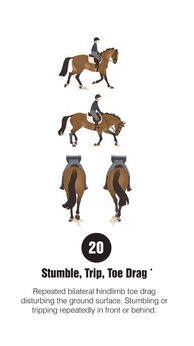Do you sometimes wish your horse could talk?
Behaviour is their communication
A horse can only communicate discomfort through their behaviour or performance, but how often are these labelled as "bad behaviour". How often are horses just called grumpy, difficult or lazy, and for horses that buck or rear from pain, explosive?
We all want to do our best for our horses, and to believe that they are happy and comfortable. In order to know that they are comfortable, we have to get better at recognising when they are uncomfortable. Several studies show that we’re not good at recognising lameness. We can all see when a horse is obviously limping. But how about when he’s just slightly unlevel, or when he’s lame on more than one leg, or when he’s just as lame on his right hind as he is on his left hind so he still moves symmetrically?
We can use ridden behaviour to recognise pain and discomfort
The Ridden Horse Performance Checklist (also know as Ridden Horse Pain Ethogram (RHpE)) developed by Dr. Dyson and colleagues is a list of 24 behaviours, the majority of which are ten or more times likely to be seen in a horse with musculoskeletal pain. Studies have shown that a horse who shows 8 or more of the 24 behaviours listed in the ridden horse pain ethogram is likely to have musculoskeletal pain. This could be useful, for example, when there’s no lameness visible in hand, or when it’s so low level that it’s hard to see, or when the compensatory patterns of the horse’s movement mask the lameness.
You can get an idea of the impact of the performance check list through the award winning film, ‘The 24 Behaviours of the Ridden Horse in Pain: Shifting the Paradigm of How We See Lameness’.
Assess & record your horses performance score
Performance Animal Physiotherapy recommends you assess your ridden horses RHeP performance score at least every 3 months.
Doing this allows you to;
-
monitor their individual behaviours and record their score
-
know when a vet assessment may be advisable if they already score 8 or more
-
track the trends of their score - is it increasing, decreasing or staying the same?
Assessing and recording a horses score over time is hugely valuable to the rider and trainer to ascertain if the horse is comfortable at the level they are training/competing at. It could help detect early signs of musculoskeletal problem and prevent more serious injury.
For horses in rehabilitation, regularly assessing the RHpE score can help determine whether they are comfortable with the pace of return to work. It can be easy to rush a rehab, but by closing monitoring your horses behaviour you can quickly identify if they are comfortable in their work.
How to complete the Ridden Horse Performance Assessment?
To assess your horse you should have someone watch you ride for 5-10 minutes at the walk, trot and canter at the level your horse currently trains. The assessment should include some of the movements required in the dressage test you compete at, or for jumpers how you would normally school your horse, ie with flying or simple changes, lateral work etc.
The assessor should watch the video above that explains the behaviours you are looking out for (also available in picture form to view on your mobile below). The assessor should stand in two corners of the school (or area your working in) to see the horse in both directions from the side, head on and away. Having the checklist to hand (download below), any behaviours under the specifications described should be marked when observed. After 10 minutes or when the horse has been viewed in all three paces in both directions, the score can be calculated by simply adding up the checked points observed during the assessment.
If you would like help performing the assessment, book a ridden session this us where we can guide you through the process of assessing your horses score and complete this for you. Enquire to book.


















































